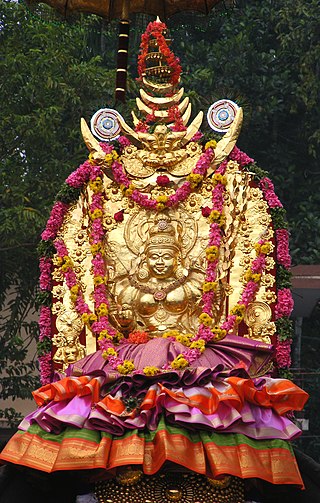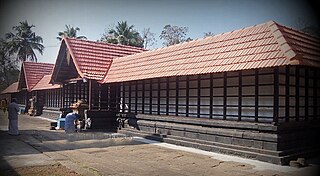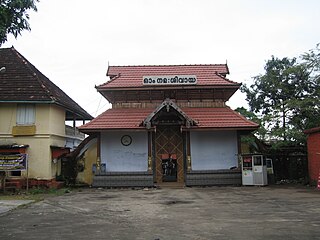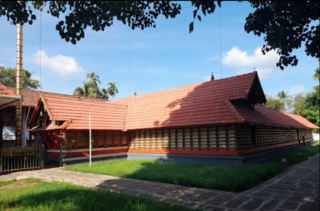
The Vadakkumnathan Temple is an ancient Hindu temple dedicated to Shiva in Thrissur, in the Thrissur district of Kerala, India. The temple is a classical example of the architectural style of Kerala and has one monumental tower on each of the four sides in addition to a koothambalam. Mural paintings depicting various scenes from the Mahabharata can be seen inside the temple. The shrines and the Kuttambalam display vignettes carved in wood. The temple, along with the mural paintings, has been declared as a National Monument by India under the AMASR Act. According to popular local lore, this is the first temple built by Parashurama, the sixth avatar of Vishnu. Thekkinkadu Maidan, encircling the Vadakkumnathan Temple, is the main venue of the renowned Thrissur Pooram festival.
Azhakodi Devi Temple or Azhakodi Devi Mahakshethram is a Hindu temple located in Thiruthiyad, Kozhikode District, Kerala, South India. It is one of the famous Devi temples, situated hardly 1.5 km away from the Mofussil Bus stand and 2.5 km from the KSRTC Bus stand, the area still retains the beauty and charm of un-spoilt rural settings within the heart of the Kozhikode city. The temple and the Kalayana Mandapom are administered by the Malabar Devaswom Board.

Kumaranalloor is a suburb of Kottayam city, Kottayam taluk, Kerala, India. Kottayam city is just 5 km south of Kumaranalloor. The region was administered by the Kumaranallur grama panchayath till 2010, before the local self-governing body was merged into the Kottayam municipality. The former Panchayath office now exists as the regional administrative office for the municipality. The village is situated on the banks of Meenachil river.

The Vilwadrinatha Temple is a Hindu temple in Thiruvilwamala, a town in the city of Thrissur, Kerala, India. The principal deities are Rama, the seventh incarnation of the god Vishnu, and his brother, Lakshmana. It figures among the Abhimana Kshetrams in Vaishnavite traditions. This is one of the four major Rama temples in Kerala — the other three are in Thriprayar, Kadavallur, and Thiruvangad. The temple houses an idol of Lakshmana, which is rare in India. Vilwadrinatha Temple is located in the centre of the community of Thiruvilwamala, atop a 100-foot-high hillock. Visible from the temple is Bharathappuzha, the second-largest river in Kerala, which flows past the temple's northern side from around 3 kilometres away.

Anandavalleeswaram Sri Mahadevar Temple in Kollam city is one of the ancient Hindu temples in Kerala, India. Lord Siva and Goddess Anandavally are the main deities of the temple. According to folklore, sage Parashurama has installed the idol of Lord Shiva. The temple is a part of the 108 famous Shiva temples in Kerala. It is located at Anandavalleeswaram, a major neighborhood of Kollam city, that comes to the west side of Kollam Collectorate.

The Sreevallabha Temple is a highly orthodox Hindu temple dedicated to Sreevallabha, a form of Vishnu. It is located in the city of Thiruvalla, in India.

Thumpamon Vadakkumnatha Temple is an ancient temple near Pandalam in Pathanamthitta in Kerala, India. This temple has two Sreekovils. Both Sreekovils are round (vatta). It is an age old temple whispering several fascinating legends of the bygone eras.

Sri Vasudevapuram Temple is one of three ancient temples (Maha-Kshetram) on the Southern bank of holy river Bharathapuzha. It sits east of the other two, Maha-Shiva Temple and Brahma temple. These temples along with the famous Thirunavaya Maha-Vishnu temple across the river form the trilogy in Sanatana Dharma). Tavanur is called Muvaankara (മൂവ്വാങ്കര). Brahma, Vishnu, and Shiva are the presiding deities, so it was initially known as Muvalankara, and then Muvaankara. Vasudevapuram Tavanur is situated in the middle of a wooded area resembling that of Sabarimala.

Ettumanoor Mahadeva temple is an ancient Shiva temple in Kottayam, Kerala, India. Temple tradition has it that the Pandavas and the sage Vyasa had worshipped at this temple. The name of the place has its origin from the word manoor, which means "the land of deer." The temple is one of the major Shiva temples in Kerala, along with Vaikom Temple, Chengannur Mahadeva Temple, Kaduthruthy Mahadeva Temple, Ernakulam Shiva Temple, Vazhappally Maha Siva Temple, Vadakkunathan temple and Sreekanteswaram Mahadeva Temple, Thiruvananthapuram.

Ernakulam Shiva Temple, also known as Ernakulathappan Temple is one of the major temples of Kerala, located in heart of Ernakulam, Kochi,Kerala, India. The temple, dedicated to Lord Shiva, is considered as the city temple, with the presiding deity as the protector of the city, as per local Hindu faiths and traditions. As per the common practice in Kerala, the deity is reverently called Ernakulathappan, which means Lord of Ernakulam. The temple is located within the Durbar Hall Ground. The temple history itself has deep association with history of the city and was one of the 7 royal temples of Kochi Maharajas. The temple is now under administration of Cochin Devaswam Board. The temple in its current form was built under active patronage of Diwan Sri Edakkunni Sankara Warrier in year 1846 and raised it level of a Royal temple in the Kochi Kingdom. The temple is built on 1-acre (4,000 m2) land. The temple is one of the major Shiva temples in Kerala counted along with the Ettumanoor Mahadevar Temple, Kaduthruthy Mahadeva Temple, Vaikom Temple, Chengannur Mahadeva Temple, Vadakkunathan temple, and Sreekanteswaram Mahadeva Temple, Thiruvananthapuram.

Vazhappally Maha Siva Temple is a Hindu temple located in Vazhappally near Changanassery in Kottayam district in the Indian state of Kerala. The temple is administered by the Travancore Devaswom Board. The temple is believed to be constructed by the first Chera king of Kodungallur. The legends suggest that the installation of the idol of god Mahadeva (Shiva) was performed by Parasurama himself. This temple is one among the 108 Shiva temples established by Parasurama. It is one of the few temples in Kerala where two nalambalams and two flag-masts are dedicated. The temple, a Grama Kshetra, also contains some seventeenth century wood carvings depicting figurines from epics. A Vattezhuttu inscription on the northern part of the base of the cultural shrine indicates that the repairs were completed in Kollam Era 840 (1665 CE).
Chittoor Sree Krishnaswamy Temple, located at South Chittoor in the city of Kochi, Kerala, India, is a temple dedicated to Lord Krishna. It is a major temple under the Cochin Devaswom Board. For centuries the temple was closely associated with the Kartha family of Cheranelloor Swaroopam and was later taken over by Rama Varma Maharaja of Cochin Royal Family. It is a classic example of Kerala temple architecture.

Thirumittakode Anchumoorthi Temple is a Hindu temple equally associated with the deities Vishnu and Shiva. Temple is situated on the banks of the Bharathappuzha at Thirumittacode of Palakkad District in Kerala state in India. The five statues - one for Shiva and four Vishnu - are known here as Thirumattikodu five (Anchu) Moorthy Temple.

Triprangode Siva Temple is a Hindu temple located at Triprangode, near Tirur, Malappuram district, Kerala.
The Mithrananthapuram Trimurti Temple is a Hindu temple complex in Thiruvananthapuram, Kerala, India. It is a temple in where devotees get to offer worship to all the three Trimurti deities, namely,. The Temple is located on the western side of Padmanabhaswamy temple in Thiruvananthapuram.

The Sree Subrahmanya Swamy Temple (Perumthrikkovil), also known as Kerala Palani or Dakshina Palani (lit. 'Southern Palani'), in Haripad, Kerala, is one of the oldest and largest temples in the region. According to belief, the temple predates the beginning of Kali Yuga. This temple holds the distinction of being the largest Subrahmanya Swami Temple in Kerala, and features the longest golden flagpost, known as the dhwajastambha (kodimaram in Malayalam). The temple's main deity is believed to embody not only Subrahmanya Swamy but also Lord Shiva and Lord Vishnu, making it a highly revered and powerful place of worship.

Kandiyoor Sree Mahadeva Temple is an ancient Shiva temple situated in Kandiyoor near Mavelikkara on the banks of Achankovil river. Kandiyoor was once the capital of the Odanadu kingdom. The temple and region are related to the history of ancient Buddhism in Kerala. Mattom Sree Mahadeva Temple also known as shiva nada is 1 kilometre (0.62 mi) west of Mavelikkara town north of State Highway 6. It is spread across an area of 7.5 acres (3.0 ha).
Reflecting the religious constitution of the population, a large number of Hindu temples and Christian churches dot the townscape of Kottayam district. Some of them are the Thirunakkara Mahadeva temple, Kumaranalloor Devi temple, Thiruvarrpu Sri Krishna Temple, Thaliyil Mahadeva Temple, Pallippurathukavu Bhagavathi Temple, Elia Cathedral, Kottayam Valiya Pally, Manarcad Cathedral, Cheriya Palli, CSI Holy Trinity cathedral, Puthuppally St. George Church and Thazhathangadi Juma Masjid. All the temples of Kottayam were also built under royal patronage of Hinduism during the 2nd millennium.
Amayannoor is a village in Kottayam district in the Indian state of Kerala. Administratively, it falls under Ayarkkunnam panchayath. It is located about 1.7 km from Ayarkkunnam, 4.6 km from Manarcaud and 8.1 km from Kidangoor.

Sree Rama Swami Temple is an ancient Hindu temple located in Ramapuram village in Meenachil tehsil and near Pala in Kottayam district in the Indian state of Kerala. The temple is classified one among the 108 Abhimana kshetrams of Vaishnavate tradition. The temple has Lord Rama as principal deity, facing the east, who is in a four-armed form, Chathurbahu. It is managed by a trust called Ramapuram Devaswom consisting of three Nambudiri families of Amanakara mana, Kunnoor mana and Karanattu mana.




















